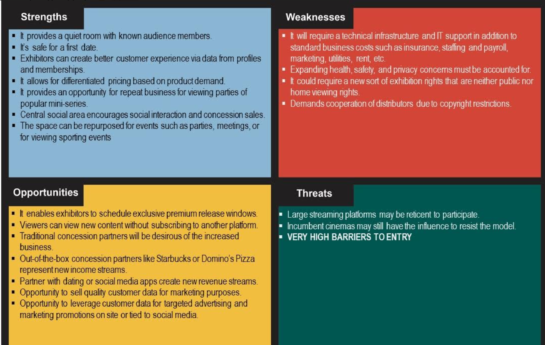
Ex-Streams: The False Dichotomy of Motion Picture Exhibition
There is nothing better than a good old-fashioned false dichotomy to fuel a meaningless debate. The dichotomy du jour is whether cinemas or streaming services will become the prevailing outlet for motion picture releases in a post-COVID 19 world. Spoiler alert: it’s probably neither.
Some believe streaming services and COVID-19 have disrupted the cinema experience but that’s not actually accurate. To better understand why, let’s tiptoe through the land of business buzzwords and reexamine “disruptive innovation.”
Consider how Clayton M. Christensen, the high priest of disruptive theory, describes it:
“Disruption” describes a process whereby a smaller company with fewer resources is able to successfully challenge established incumbent businesses. Specifically, as incumbents focus on improving their products and services for their most demanding (and usually most profitable) customers, they exceed the needs of some segments and ignore the needs of others. Entrants that prove disruptive begin by successfully targeting those overlooked segments, gaining a foothold by delivering more-suitable functionality—frequently at a lower price. Incumbents, chasing higher profitability in more-demanding segments, tend not to respond vigorously. Entrants then move upmarket, delivering the performance that incumbents’ mainstream customers require, while preserving the advantages that drove their early success. When mainstream customers start adopting the entrants’ offerings in volume, disruption has occurred.
Streaming platforms are incumbent in the home video segment of media distribution and exhibition, while the cinemas are incumbent traditional exhibitors. All of them “focus on improving their products and services for their most demanding (and usually most profitable) customers.” They raise their prices and pursue exclusive content or elaborate amenities to capture avid audiences.
They also “… exceed the needs of some segments and ignore the needs of others.” Casual, cost-conscious viewers’ needs are exceeded, but what is the overlooked segment? It’s 18- to 36-year-olds, who want to stream video in their own time and manner, but want to do it in a public, social setting.
Are those two things truly incompatible? These overlooked viewers may want to get together with a group of friends to watch something, but they can scarcely do so in their micro-apartments.
They may want to get together with someone they just met on a dating app, but inviting someone to your place for a first date is very awkward, and it may require washing the underwear that’s been festooned around the place for a month now.
I believe a smart, disruptive, post-pandemic innovator will create a space that is like a coffee shop, with a central area where people can socialize, but with multiple side rooms, laid out like home theaters. There are numerous operational and profitability models that could make such a place work, but from the consumer point of view, it would offer the opportunity to watch what they want, when they want, in a very comfortable setting.
 Strengths
Strengths
This proposal offers a social setting with the flexibility of streaming, to draw enthusiastic young customers. It offers greater privacy than cinemas, without distractions like crying babies, rattling candy wrappers, and noisy cell phone gabbers. It’s a safer and more convenient date night location than the home. If this streaming cinema ran on a membership system, the business could get to know its customers through data and deliver them a better experience.
Perhaps rates could be adjusted based on demand for the content so tickets for blockbusters and romcoms are no longer sold at the same price.
It has an advantage for repeat business, such as weekly viewing parties for episodic series. Having the central café-like area encourages concession sales and social media activity. The space could also be repurposed for other gatherings like parties or business meetings.
Weaknesses
The streaming cinema would require extensive technical infrastructure and IT support in addition to standard business costs. There are also expanding health, safety, and privacy concerns to be addressed. It calls for a new kind of exhibition rights, which would be very complicated to create, and it couldn’t be done without the cooperation of distributors.
Opportunities
If this system took the place of traditional cinemas, it could replicate the opening-weekend surge of viewership while maintaining the privacy and flexible timing of on-demand viewership. If deals could be reached with streaming services, content could be sampled from multiple platforms, doubling as a marketing tool for those platforms.
(Struum and the Roku Channel are already using this model.) Sarah Perez, Former Disney and Discovery execs to launch Struum, a ‘ClassPass for streaming services’, TechCrunch (Jan. 7, 2021, 8:25 AM PST),; Brian Welk, Discovery+ Makes Deal With Roku, Dodges HBO Max and Peacock’s Carriage Issues, The Wrap (Jan. 4, 2021, 5:30 AM),. Viewer data could be sold for marketing purposes. Traditional concession partners that have been impacted by declining cinema attendance could benefit, and the café-like setting could invite new partners. There also could be technological partnerships with social media or dating apps.
Threats
The incumbent streaming giants could be reticent to participate, though it may be in their best interests not to appear anticompetitive. Incumbent cinemas, while financially unstable, may still have enough influence to resist this model.
However, the biggest threat of all is the barrier to entry. It would take someone with significant assets and connections to pull it all together. It would require making smart real estate deals, the ability to coordinate with local governments, and the technological sophistication required to operate the venue. It would also take someone with substantial entertainment industry connections to deal with the guilds and the distributors.
In addition, the owner would have to maintain partnership deals with maintenance, concessions, advertisers, social media outlets, and others. It’s also notable that there is nothing patentable here to keep competition at bay in the early stages. On the other hand, the high barriers to entry could be enough to protect a sufficiently equipped first mover. One critical component would be developing a functional technical infrastructure. Building that would be a strong first step toward disruption.

So, while the concept seems to be a winning disruptive innovation at first, it may not adhere to Clayton Christensen’s disruptive theory because it requires the cooperation of incumbent players. Large entities like Roku or Amazon may have the resources and connections to create the necessary disruption.
Alternatively, if mom-and-pop coffee shops across the country simply make their venues more conducive to streaming, they might be able to create some innovative disruption, but they risk legal battles over performance rights.
In 1984, a company that provided both VHS tape rentals and screening rooms to watch the tapes — the equivalent of this proposal for the technology of the time — was shut down because they were held to be publicly performing the content. Columbia Pictures Industries, Inc. v. Redd Horne, Inc., 749 F.2d 154 (3d Cir. 1984); see also Video Rental Rooms Fought, from the New York Times. Yes, simply watching a movie on your laptop at your favorite coffee shop is technically illegal.
I believe the choice between cinemas or streaming at home to be a false dichotomy, and the established media companies should anticipate some form of innovative disruption in the very near future.
For a more detailed busines proposal for the streaming cinema, see my SlideShare here.
Alan Shimp is a 19-year-old, third-year law student at UCLA earning a certificate in entertainment law who would love nothing more than to work in business and legal affairs in the media and entertainment industry. He’s co-author of The Film Fan Handbook series. Connect with him on LinkedIn.
